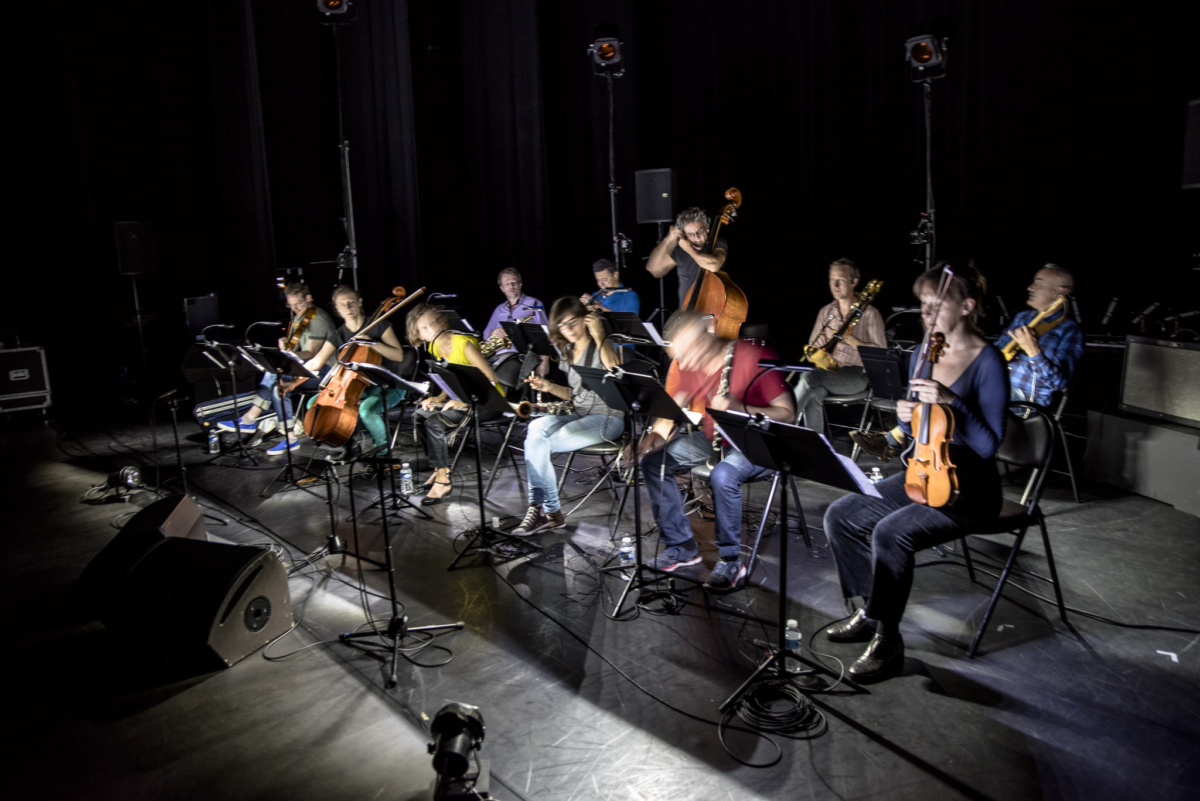READER: MOTOR TAPES
08.08.2023

Sarah Hennies: “Motor Tapes” (2022/23) – World Premiere 60′
for 12 musicians
Commission Ensemble Dedalus
PAUSE
Brian Eno: “Music for Airports” (1978) 45′
ensemble version by Didier Aschour
Ensemble Dedalus

Ensemble Dedalus:
Amélie Berson (Flute)
Fabrice Villard (Clarinet)
Pierre-Stéphane Meugé (Saxophone)
Christian Pruvost (Trumpet)
Thierry Madiot (Trombone)
Stéphane Garin (Vibraphone & Percussion)
Denis Chouillet (Piano)
Didier Aschour (Guitar & Artistic Direction)
Silvia Tarozzi (Violin)
Cyprien Busolini (Viola)
Judith Hamann (Violoncello)
Eric Chalan (Double Bass)
Benjamin Maumus (Sound Direction)
MOTOR TAPES
“Motor Tapes” is composed of densely overlapping repetitions and rhythmic patterns that evoke neuroscientist Rodolfo Llinás‘s study of the human brain. In his book “I of the Vortex” he coined the term, “motor tapes” to describe the neural embodiments that facilitate all mental activity and in it posits that the brain contains innumerable “tapes” that run continuously within the mind. Llinás’s characterization of this phenomena is strikingly musical: “The activity in the basal ganglia is running all the time, playing motor patterns and snippets of motor patterns amongst and between themselves […] they seem to act as a continuous, random, motor pattern noise generator.” In my work of the same name, musicians represent synapses that fire independently and sometimes coordinating and coalescing into complex, interwoven activities.
The work is also inspired by involuntary musical imagery, more commonly known as earworms. Llinás describes human physical and mental activity as various “tape” coordinating both voluntary and involuntary events of which the earworm is one of the most common. In Oliver Sacks’s “Musicophilia” he studied individuals who experience musical hallucinations, auditory illusions distinct from when one hears music playing in their head but rather, someone who experiences auditory hallucinations hears the music as though it were physically in the room with them. Sacks noted that the music heard by patients were invariably songs from their childhood and thus my piece “Motor Tapes” is punctuated by transformed and warped melodies from my childhood.
I am interested in the motor tapes theory because it suggests that alongside lived experience there is a mysterious biological basis for our inclinations, talents and identities.
Sarah Hennies
AMBIENT MUSIC
The concept of music designed specifically as a background feature in the environment was pioneered by Muzak Inc. in the 1950s, and has since come to be known generically by the term “Muzak”. The connotations that this term carries are those particularly associated with the kind of material that Muzak Inc. produces – familiar tunes arranged and orchestrated in a lightweight and derivative manner. Understandably, this has led most discerning listeners (and most composers) to dismiss entirely the concept of environmental music as an idea worthy of attention.
Over the past three years, I have become interested in the use of music as ambience, and have come to believe that it is possible to produce material that can be used thus without being in any way compromised. To create a distinction between my own experiments in this area and the products of the various purveyors of canned music, I have begun using the term Ambient Music.
An ambience is defined as an atmosphere, or a surround- ing influence: a tint. My intention is to produce original pieces ostensibly (but not exclusively) for particular times and situations with a view to building up a small but versatile catalogue of environmental music suited to a wide variety of moods and atmospheres.
Whereas the extant canned music companies proceed from the basis of regularizing environments by blanketing their acoustic and atmospheric idiosyncracies, Ambient Music is in- tended to enhance these. Whereas conventional background music is produced by stripping away all sense of doubt and uncertainty (and thus all genuine interest) from the music, Ambi- ent Music retains these qualities. And whereas their intention is to ‘brighten’ the environment by adding stimulus to it (thus supposedly al- leviating the tedium of routine tasks and levelling out the natural ups and downs of the body rhythms), Ambient Music is intended to induce calm and a space to think.
Ambient Music must be able to accomodate many levels of listening attention without enforcing one in particular; it must be as ignorable as it is interesting.
Brian Eno (1978)






